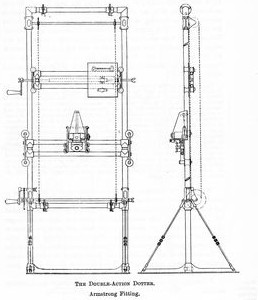Catalogue number
Admiral Sir Percy Scott and naval gunnery
As the performance of naval guns improved so the distance for engagement increased and the control of gun fire became more and more important. One of the pioneers of naval gunnery and director firing was Admiral Sir Percy Scott (1853 – 1924) of the Royal Navy. Scott devised and developed numerous systems to improve gunnery and increase the number of hits despite Admiralty hesitation and obstruction. One device that turns up in old photographs is the dotter, a training machine for gunlayers by which the gun team can develop their skill in coordinating the union between following the target in the eye sight and laying the gun. Basically, the dotter is a carrying frame within which a target can be moved up and down as well as sideways. Fixed to the gun barrel is a pointer that is also held in the frame. The target is to the back of the frame and the pointer to the front. When the gun crew consider that the gun barrel/pointer is on target, “fire” the gun. By an electro-magnetic system, the pointer moves to hit and mark the target with a dot (hence the name “dotter”).
The Naval Annual, 1913, Griffin & Co.
|
 |